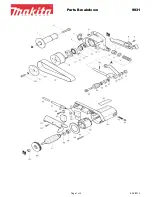
ASSEMbLY & ADJUSTMENTS
MOUNTING DISC SANDER TO wORKbENCh
If the disc sander is to be used in a permanent location, it should be fastened securely
to a firm supporting surface such as a workbench. If mounting to a workbench, holes
should be drilled through supporting surface of the workbench.
1. The bolts which secure the 4 rubber feet (A) Fig.3 must be removed. To reduce vi-
bration, it is recommended to keep the 4 rubber feet positioned between the sander
base and the workbench.
2. Locate and mark the holes where disc sander is to be mounted on workbench.
3. Drill 4 holes throught workbench.
4. Place disc sander on workbench aligning holes on base/rubber feet with holes drilled
in workbench.
5. Use hex. bolts, washers and hex nuts (not included) to secure.
CLAMPING DISC SANDER TO wORKbENCh
The disc sander can also be clamped directy to a workbench using two or more "C"
clamps on base of the sander.
INSTALLING 12” SANDING DISC
Locate the 12” sanding disc (A) Fig.4, peel off the backing (B) as shown, slide the
sanding disc in between the table and the aluminum disc (C). Align the sanding disc
and aluminum disc, once perfectly aligned, apply pressure on the entire sanding disc
to ensure proper fitment.
SqUARING & TILTING TAbLE
The tilting table (A) Fig.5 can be tilted downwards from 0
0
-45
0
and upwards 0
0
-30
0
.
The bevel angle scale (B) is provided as a guide, but for precise adjustment it is
recommended to use a square.
1. Loosen the spring loaded lock handles (C) Fig.5 on both sides of the table. Position
a square (D) on the table up against the sanding disc.
2. Adjust the position of the table so the square is perfectly perdendicular to the sanding
disc.
3. Once adjusted, retighten the spring loaded lock handles (C) Fig.5.
USING & SqUARING ThE MITER GAUGE
The miter gauge (A) Fig.6 gets positoned in the slot (B) of the table. The miter gauge
comes with a degree scale (C) as a guide, but for precise adjustment it is recom-
mended to use a square.
1. Position a square (D) Fig.6 against the miter gauge body and the sanding disc as
shown.
2. Loosen the miter gauge lock knob (E) and adjust the miter gauge body angle so it
rests against the square. Retighten lock knob.
Figure 3
Figure 4
Figure 5
Figure 6


























